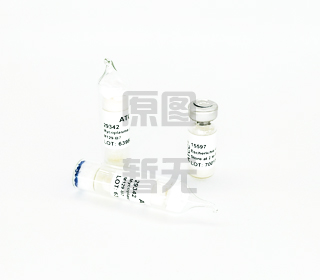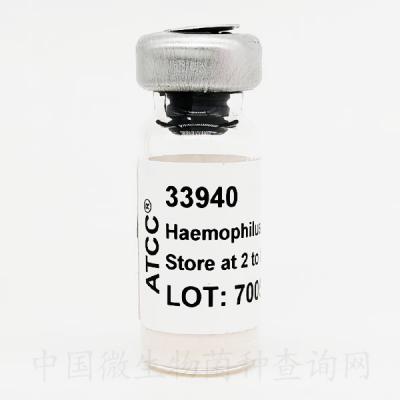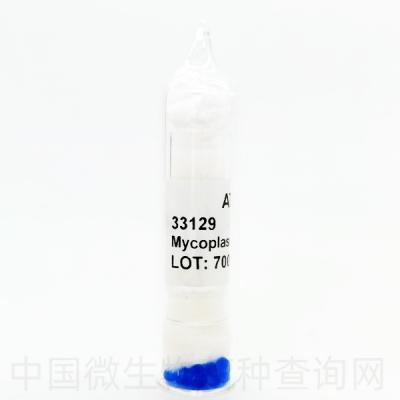
ATCC® Number:30234™
Organism: Acanthamoeba castellanii (Douglas) Page
Isolation: derived from ATCC30011
Depositors: W Balamuth
Biosafety Level:1
Shipped: frozen
Growth Conditions: ATCCmedium 712: PYGTemperature: 25.0°C Growth Conditions: Axenic Protocol: This strain is distributed as a frozen preparation. See the general procedures for thawing a frozen vial. Once vial is thawed, aseptically transfer the entire contents to the center of an agar plate of ATCCmedium 711 and spread it evenly over the surface of the plate with a spread bar. Incubate the plate at 25C. Trophozoites (amoebae) should be evident within 2-3 days.
Permits/Forms: In addition to the MTA mentioned above, other ATCC and/or regulatory permits may be required for the transfer of this ATCC material. Anyone purchasing ATCC material is ultimately responsible for obtaining the permits. Please click here for information regarding the specific requirements for shipment to your location.
Comments: infection by Chlamydia pneumoniae [38798] enhancement of virulence of Mycobacterium avium [29894] Intracellular growth of Legionella pneumophila [4709] Survival of bacterial pathogens within protozoa [4927] phylogeny [24028] Growth of Legionella pneumophila [24067]
Classification: KINGDOM: Protozoa
References: 4709: Moffat JF, Tompkins LS. A quantitative model of intracellular growth of Legionella pneumophila in Acanthamoeba castellanii. Infect. Immun. 60: 296-301, 1992. PubMed: 1729191 4927: King CH, et al. Survival of coliforms and bacterial pathogens within protozoa during chlorination. Appl. Environ. Microbiol. 54: 3023-3033, 1988. PubMed: 3223766 23896: Daggett PM, et al. Distribution and possible interrelationships of pathogenic and nonpathogenic Acanthamoeba from aquatic environments. Microb. Ecol. 8: 371-386, 1982. 24028: Daggett PM, et al. A molecular approach to the phylogeny of Acanthamoeba. Biosystems 18: 399-405, 1985. PubMed: 4084681 24067: Cirillo JD, et al. Growth of Legionella pneumophila in Acanthamoeba castellanii enhances invasion. Infect. Immun. 62: 3254-3261, 1994. PubMed: 8039895 29568: Steinert M, et al. Resuscitation of viable nonculturable Legionella pneumophila Philadelphia JR32 by Acanthamoeba castellanii. Appl. Environ. Microbiol. 63: 2047-2053, 1997. PubMed: 9143134 29894: Cirillo JD, et al. Interaction of Mycobacterium avium with environmental amoebae enhances virulence. Infect. Immun. 65: 3759-3767, 1997. PubMed: 9284149 30943: Neumeister B, et al. Multiplication of different Legionella species in mono mac 6 cells and in Acanthamoeba castellanii. Appl. Environ. Microbiol. 63: 1219-1224, 1997. PubMed: 9097418 32323: Helbig JH, et al. Detection of intracellular growth of Legionella pneumophila in protozoa by antigen quantification using ELISA. Zentralbl. Hyg. Umweltmed. 194: 392-397, 1993. PubMed: 8397687 34529: Buck SL, Rosenthal RA. A quantitative method to evaluate neutralizer toxicity against Acanthamoeba castellanii. Appl. Environ. Microbiol. 62: 3521-3526, 1996. PubMed: 8795247 35057: Grimm D, et al. Specific detection of Legionella pneumophila: construction of a new 16S rRNA-targeted oligonucleotide probe. Appl. Environ. Microbiol. 64: 2686-2690, 1998. PubMed: 9647849 38798: Essig A, et al. Infection of Acanthamoeba castellanii by Chlamydia pneumoniae. Appl. Environ. Microbiol. 63: 1396-1399, 1997. PubMed: 9097437 42630: Cirillo JD, et al. Intracellular growth in Acanthamoeba castellanii affects monocyte entry mechanisms and enhances virulence of Legionella pneumophila. Infect. Immun. 67: 4427-4434, 1999. PubMed: 10456883 42691: Segal G, Shuman HA. Legionella pneumophila utilizes the same genes to multiply within Acanthamoeba castellanii and human macrophages. Infect. Immun. 67: 2117-2124, 1999. PubMed: 10225863 43568: Hales LM, Shuman HA. The Legionella pneumophila rpoS gene is required for growth within Acanthamoeba castellanii. J. Bacteriol. 181: 4879-4889, 1999. PubMed: 10438758 47083: Neumeister B, et al. Influence of Acanthamoeba castellanii on intracellular growth of different Legionella species in human monocytes. Appl. Environ. Microbiol. 66: 914-919, 2000. PubMed: 10698751 47092: Borazjani RN, et al. Flow cytometry for determination of the efficacy of contact lens disinfecting solutions against Acanthamoeba spp. Appl. Environ. Microbiol. 66: 1057-1061, 2000. PubMed: 10698771 48354: Miltner EC, Bermudez LE. Mycobacterium avium grown in Acanthamoeba castellanii is protected from the effects of antimicrobials. Antimicrob. Agents Chemother. 44: 1990-1994, 2000. PubMed: 10858369 49105: Khan NA, et al. Proteases as markers for differentiation of pathogenic and nonpathogenic species of Acanthamoeba. J. Clin. Microbiol. 38: 2858-2861, 2000. PubMed: 10921939 51822: Polesky AH, et al. Identification of Legionella pneumophila genes important for infection of amoebas by signature-tagged mutagenesis. Infect. Immun. 69: 977-987, 2001. PubMed: 11159993 51878: Dietrich C, et al. Flagellum of Legionella pneumophila positively affects the early phase of infection of eukaryotic host cells. Infect. Immun. 69: 2116-2122, 2001. PubMed: 11254565 56051: Steenbergen JN, et al. Cryptococcus neoformans interactions with amoebae suggest an explanation for its virulence and intracellular pathogenic strategy in macrophages. Proc. Natl. Acad. Sci. USA 98: 15245-15250, 2001. PubMed: 11742090 61440: Noble JA, et al. Phagocytosis affects biguanide sensitivity of Acanthamoeba spp. Antimicrob. Agents Chemother. 46: 2069-2076, 2002. PubMed: 12069957 61441: Zusman T, et al. Characterization of a Legionella pneumophila relA insertion mutant and toles of RelA and RpoS in virulence gene expression. J. Bacteriol. 184: 67-75, 2002. PubMed: 11741845 61442: Cirillo SLG, et al. Role of the Legionella pneumophila rtxA gene in amoebae. Microbiology 148: 1667-1677, 2002. PubMed: 12055287 64425: Abd H, et al. Survival and growth of Francisella tularensis in Acanthamoeba castellanii. Appl. Environ. Microbiol. 69: 600-606, 2003. PubMed: 12514047 70180: Boulanger CA, Edelstein PH. Precision and accuracy of recovery of Legionella pneumophila from seeded tap water by filtration and centrifugation. Appl. Environ. Microbiol. 61: 1805-1809, 1995. PubMed: 7646019 70295: Khan NA, et al. Acanthamoeba can be differentiated by the polymerase chain reaction and simple plating assays. Curr. Microbiol. 43: 204-208, 2001. PubMed: 11400071 70296: Khan NA. Pathogenicity, morphology, and differentiation of Acanthamoeba. Curr. Microbiol. 43: 391-395, 2001. PubMed: 11685503 70297: Khan NA, Paget TA. Molecular tools for speciation and epidemiological studies of Acanthamoeba. Curr. Microbiol. 44: 444-449, 2002. PubMed: 12000996 70308: Marolda CL, et al. Intracellular survival and saprophytic growth of isolates from the Burkholderia cepacia complex in free-living amoebae. Microbiology 145: 1509-1517, 1999. PubMed: 10439391 70341: Hilbi H, et al. Icm/dot-dependent upregulation of phagocytosis by Legionella pneumophila. Mol. Microbiol. 42: 603-617, 2001. PubMed: 11722729 70357: Hales LM, Shuman HA. Legionella pneumophila contains a type II general secretion pathway required for growth in amoebae as well as for secretion of the Msp protease. Infect. Immun. 67: 3662-3666, 1999. PubMed: 10377156 70574: Steinert M, et al. Studies on the uptake and intracellular replication of Legionella pneumophila in protozoa and in macrophage-like cells. FEMS Microbiol. Ecol. 15: 299-308, 1994. 70586: Wintermeyer E, et al. Sequence determination and mutational analysis of the lly locus of Legionella pneumophila. Infect. Immun. 62: 1109-1117, 1994. PubMed: 8112844 70609: Kohler R, et al. Expression and use of the green fluorescent protein as a reporter system in Legionella pneumophila. Mol. Gen. Genet. 262: 1060-1069, 2000. PubMed: 10660067 70610: Helbig JH, et al. Immunolocalization of the Mip protein of intracellularly and extracellularly grown Legionella pneumophila. Lett. Appl. Microbiol. 32: 83-88, 2001. PubMed: 11169048 70611: Heuner K, et al. Influence of the alternative sigma(28) factor on virulence and flagellum expression of Legionella pneumophila. Infect. Immun. 70: 1604-1608, 2002. PubMed: 11854250 70612: Wintermeyer E, et al. Influence of site specifically altered Mip proteins on intracellular survival of Legionella pneumophila in eukaryotic cells. Infect. Immun. 63: 4576-4583, 1995. PubMed: 7591108 70613: Segal Gil, et al. Relationships between a new type IV secretion system and the icm/dot virulence system of Legionella pneumophila. Mol. Microbiol. 34: 799-809, 1999. PubMed: 10564519 70615: Gal-Mor O, Segal G. The Legionella pneumophila GacA homolog (LetA) is involved in the regulation of icm virulence genes and is required for intracellular multiplication in Acanthamoeba castellanii. Microb. Pathog. 34: 187-194, 2003. PubMed: 12668142 70616: Hagele S, et al. Legionella pneumophila kills human phagocytes but not protozoan host cells by inducing apoptotic cell death. FEMS Microbiol. Lett. 169: 51-58, 1998. PubMed: 9851034 71001: Steinert M, et al. Regrowth of Legionella pneumophila in a heat-disinfected plumbing system. Zentralbl. Bakteriol. 288: 331-342, 1998. PubMed: 9861677





